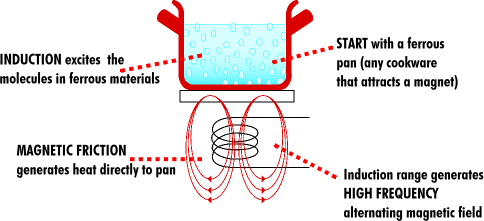How Induction Works
Induction ovens work by taking advantage of a scientific process known as hysteresis loss. Hysteresis is the name for the delayed response that some systems exhibit when affected by a force. Put another way, hysteresis loss is the unique phenomenon of ferromagnetic systems, or iron-magnetic systems, which react to new magnetic forces only in relation to how they reacted to previous magnetic force inputs. It is these ferromagnetic properties that are integral to how the induction cooker cooks the food.
When the coil of an induction cooker is electrically charged, it creates a magnetic field. A ferromagnetic cooking vessel, which includes any common household pot or pan with some iron content, is then placed over the coil, on top of the induction oven. The electrons in the iron will attempt to align their spin direction with the direction of the magnetic field.
In fact, the electrons will prefer to keep their new spins aligned in the ferromagnet, but will be forced to change as the direction of the applied magnetic field changes. The electrons will be unable to change their alignment in unison, and those that flip directions first will “rub” against their more slow-reacting neighbors. All of this “rubbing” generates molecular friction, and heat as a byproduct, warming the iron, and eventually cooking the food.

Obviously, because induction ranges use electricity to generate their magnetic field, they can also be classified as electric ranges. Unlike traditional electric ranges, they sometimes require power loads in excess of what the normal kitchen can offer. For this reason, it is important to know the specifications of the induction range you plan to purchase in relation to the electric wiring in your home.
